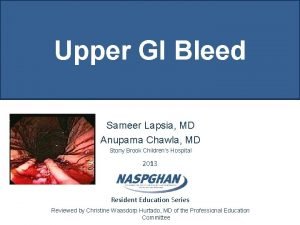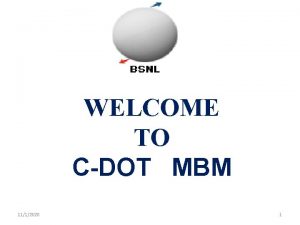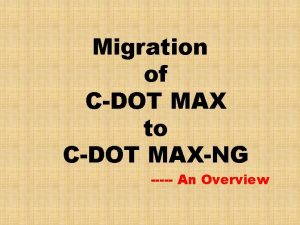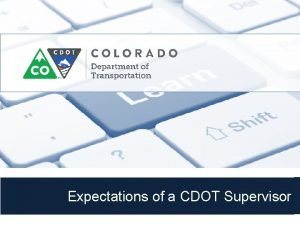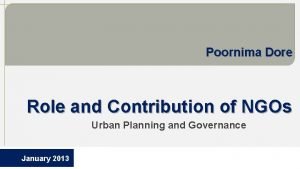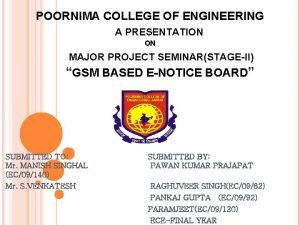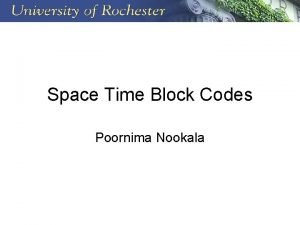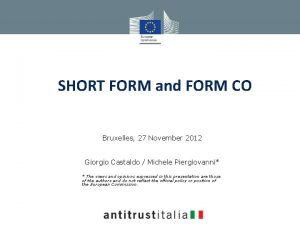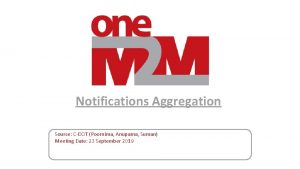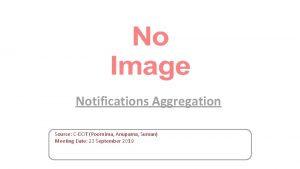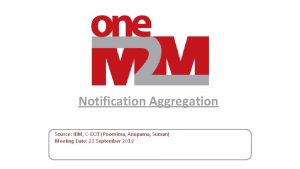Notifications Aggregation Source CDOT Poornima Anupama Suman Meeting








- Slides: 8

Notifications Aggregation Source: C-DOT (Poornima, Anupama, Suman) Meeting Date: 23 September 2019

Problem Statement. . As per section 10. 2. 7. 11 of TS-0001 • On receipt of notification, receiver CSE shall “Upon successful validation, aggregate the notifications which have the same notification. Forwarding. URI for the duration specified in notify. Aggregation or until the number of notifications specified in notify. Aggregation are received, whichever occurs first” Current design assumes notification. Forwarding. URI as basis of aggregation.

Current AGN Behavior Notification for Create at add 1, nf. URI=IP 1 Agn 1=N_CREATE, N_UPDATE IP 1 Agn 2=N_UPDATE, N_CREATE CSE 1 CREATE <subscription> with nf. URI G 1/fopt IP 2 IP 3 n. URI=IP 1 nf. URI is present CREATE <container> G 1/fopt Notification for Update at add 1, nf. URI= IP 1 CSE 2 G 1 (m 1, CSE 2/m 2) m 2 m 1 sub 2 UPDATE <container> G 1/fopt sub 1 nf. URI= IP 1 n. URI= add 1 net= C/U add 1: address of CSE 1 for aggregating the notifications n. URI= add 1 net= C/U

Issue… • Aggregation using notification. Forwarding. URI attribute individually cannot resolve this issue, as same notification. Forwarding. URI would be used across different fanout CRUD sessions. – When same/multiple originator are working on a single group simultaneously, then events from same/different originator of same/different operations may lead to generation of notifications. But since the basis of aggregation is notification. Forwarding. URI , so an aggregated notification may contain notifications of event 1 and event 2 since both are targeting to same notification. Forwarding. URI. – Hence one agn is not corresponding to one type of fanout event, instead different fanout events are merged resulting in unwanted agn to an originator.

Potential Solution…. • Aggregation can be done correctly if, each such notification carries some information from the original request. – Either to add a new request parameter to be included in each notifications derived from original request parameters. – Or to use a existing request parameter such as group request identifier

Required AGN Behavior Notification for Create at add 1, GRI 1 Agn 1=N_CREATE, N_CREATE IP 1 IN-CSE Agn 2=N_UPDATE, N_UPDATE CREATE <subscription> with nf. URI/fopt/G 1 n. URI=IP 1 nf. URI is present Notification for Update at add 1, GRI 2 CSE 2 G 1 (m 1, CSE 2/m 2) CREATE <container> G 1/fopt Generate GRI 1 m 2 m 1 sub 1 UPDATE <container> G 1/fopt Generate GRI 2 sub 1 nf. URI= IP 1 n. URI= add 1 net= C/U n. URI= add 2 net= C/U

How. . ? ? • Currently GRI is generated when group contains sub-group. To extend the use, it should be generated irrespective of sub-group. • Copy generated GRI in each individual requests to each <group> members. • Notifying CSE shall copy same GRI in each Notification requests generated corresponding to these individual fanout request. • Aggregating CSE shall use each unique GRIs along with notification. Forwarding. URI to aggregate notifications.

Positives of using GRI…. • No requirements of adding new attributes to One. M 2 M request primitive. • Minimal changes in specifications. • Ensures correct aggregation of notifications
